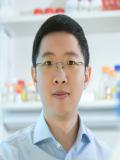Sihan Wu, PhD

Dr. Sihan Wu has an extensive background in cancer genetics and genomics. After graduating from Sun-Yat-sen University (SYSU), where he majored in biotechnology in the Life Science School, he obtained his Ph.D. in the Zhongshan School of Medicine at SYSU. Mentored by Dr. Guangmei Yan, Dr. Wu’s doctoral research focused on how genetic alterations contribute to brain tumor development, and discovered that dysregulation of non-coding microRNAs contributes to the development of glioblastoma (Shu et al., Molecular Cancer 2011; Shu et al., Molecular pharmacology 2012; Wu et al., Oncogene 2012).
After receiving his Ph.D., Dr. Wu initiated postdoctoral research at the Ludwig Institute for Cancer Research at the University of California, San Diego, under Dr. Paul Mischel's mentorship. His postdoctoral research focused on the structure and function of extrachromosomal DNA (ecDNA) in cancer, revealing its circular shape and the functional impact of its unique physical conformation.
One of the most common genetic alterations causing cancer is oncogene amplification. Instead of 2 copies, a cancer cell might have 10, 20, 30, or even more copies of an oncogene, promoting unrestrained proliferation. The development of high-throughput sequencing and the human genome map have been critical tools to understand the genetic changes that occur in cancer cells. However, many amplified oncogenes are not physically located where the genomic maps indicate. Instead, they are frequently amplified on ecDNA particles.
ecDNA was first described in cancer in 1965, but it was thought to only occur in 1.4% of cancers. Recent studies, including Dr. Wu’s research into the ecDNA landscape of clinical tumor samples, have revealed a surprisingly high prevalence of ecDNA in some human cancers, especially in aggressive cancers like those of the brain, lung, and breast (Turner et al., Nature 2017; Kim et al., Nature genetics 2020). Accumulating evidence suggests that ecDNA is driving malignant behaviors in cancer cells, such as drug resistance (Nathanson et al., Science 2014).
Given the prevalence of ecDNA in cancer, Dr. Wu sought to interrogate the most fundamental question: what is the structure of ecDNA and its impact on gene regulation? By integrating whole-genome sequencing, long-range optical mapping, and super-resolution imaging, Dr. Wu’s research demonstrates that ecDNA is circular. By pan-cancer genomic and transcriptomic analyses, he revealed that oncogenes encoded on ecDNA are among the most highly expressed genes in the transcriptome, linking elevated DNA copy with high transcription levels. He then applied sequencing and imaging to assess the chromatin state quantitatively and revealed that, while ecDNA is chromatinized with intact topologically associating domain structure, it lacks higher-order compaction (i.e., heterochromatin) typical of chromosomes, and displays significantly enhanced chromatin accessibility. Further, by chromatin conformation capturing and sequencing, Dr. Wu’s research shows that ecDNA has significantly enhanced ultra-long-range active chromatin contacts, providing new insight into how circular ecDNA structure impacts oncogene function, bridging ecDNA biology with modern cancer genetics and epigenetics (Wu et al., Nature 2019). This information might allow us to therapeutically target the replication or transcription of ecDNAs, undermining the expression of amplified oncogenes, including the ones (such as MYC) that still cannot be targeted through traditional pharmacological approaches.
Financial relationships
-
Type of financial relationship:There are no financial relationships to disclose.Date added:04/08/2022Date updated:04/08/2022
**Disclaimer**
This Continuing Medical Education (CME) Learning Management System, Ethos, includes individuals designated as 'faculty' for CME purposes. Please note that the term 'faculty' refers solely to their role as a contributor/planner within a CME activity and does not imply any formal affiliation with UT Southwestern Medical Center (UTSW). The display of names and credentials is intended for educational purposes only and does not necessarily indicate a professional or academic relationship with UTSW. Participants are encouraged to verify the affiliations and credentials of faculty members independently if further clarification is needed.

 Facebook
Facebook X
X LinkedIn
LinkedIn Forward
Forward